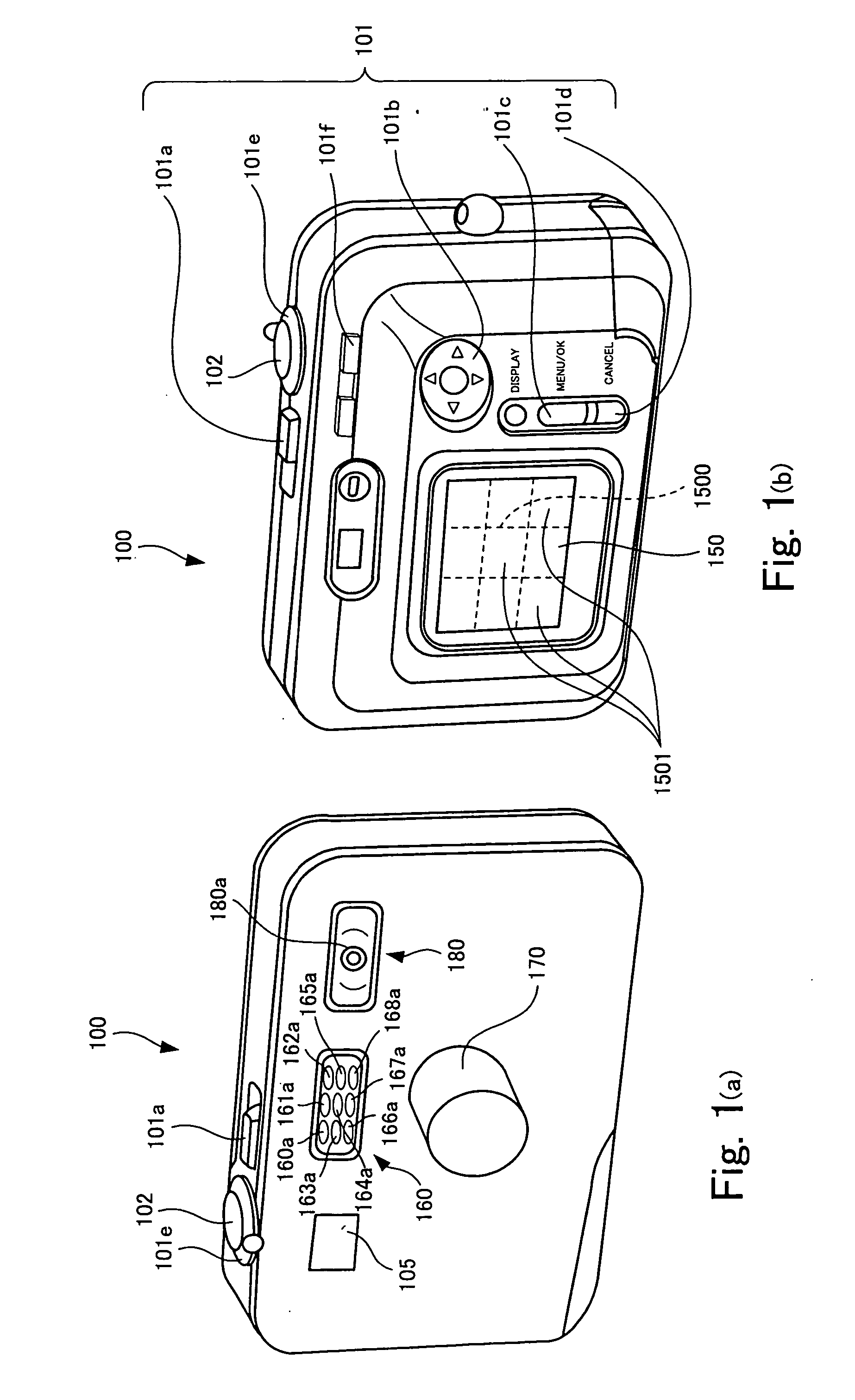Image-taking apparatus
- Summary
- Abstract
- Description
- Claims
- Application Information
AI Technical Summary
Benefits of technology
Problems solved by technology
Method used
Image
Examples
first embodiment
[0044] As shown in FIG. 1(a), a finder 105, an LED emission section 160 and a xenon-tube emission section 180 are disposed above the lens barrel 170 of the digital camera 100. The LED emission section 160 has LEDs 160a through 168a and irradiates a subject with fill light for shooting emitted from these LEDs. Although the digital camera 100 shown in FIG. 1(a) is provided with plural LEDs 160a through 168a, only one LED may be provided instead. The xenon-tube emission section 180 has a xenon tube 180a and irradiates a subject with fill light for shooting emitted from the xenon tube 180a, which light is relatively higher in intensity than the light from the LED emission section 160. Because the xenon tube 180a is capable of emitting light whose intensity is higher than the LEDs 160a through 168a, the xenon-tube emission section 180 can irradiate a subject with an appropriate amount of light required for exposure in a short time. In contrast, the LEDs 160a through 168a can be quickly r...
second embodiment
[0078]FIGS. 6, 7 and 8 are diagrams to describe a second embodiment according to the invention.
[0079]FIG. 6 is a block diagram illustrating the internal configuration of a digital camera according to the second embodiment.
[0080] The digital camera of the second embodiment is the same as the digital camera 100 of the first embodiment shown in FIG. 2 except that a motion vector detector 1103 is provided in place of the angular-velocity sensor 1101. The motion vector detector 1103 detects a subject-image movement formed on a CCD 112 by reading out image signals from a buffer memory 115 and comparing the read-out image signals with previously read-out image signals and outputs the result of the detection as a motion vector. What the motion vector detector 1103 detects here is a subject-image movement in an area designated by a main CPU 110. The main CPU 110 designates a distance-measurement area, i.e. AF area, selected as an area to be focused from among plural distance-measurement are...
third embodiment
[0090]FIGS. 9, 10 and 11 are diagrams showing a third embodiment according to the invention.
[0091]FIG. 9 is a block diagram illustrating the internal configuration of a digital camera according to the third embodiment.
[0092] The digital camera of the third embodiment is the same as the digital camera 100 of the first embodiment shown in FIG. 2 except that a face-recognition section 1105 and a motion vector detector 1107 for detecting a subject-image movement in an area including a face position detected by the face-recognition section 1105 are provided in place of the angular-velocity sensor 1101.
[0093] Since other elements and the appearance of the digital camera according to the third embodiment are the same as those of the first embodiment shown in FIGS. 1 and 2, the same reference characters as those of the first embodiment are used here and the description thereof will be omitted.
[0094]FIG. 10 shows distance-measurement areas 15011, 15012, 15013, 15014, 15015, 15016, 15017, ...
PUM
 Login to View More
Login to View More Abstract
Description
Claims
Application Information
 Login to View More
Login to View More - R&D
- Intellectual Property
- Life Sciences
- Materials
- Tech Scout
- Unparalleled Data Quality
- Higher Quality Content
- 60% Fewer Hallucinations
Browse by: Latest US Patents, China's latest patents, Technical Efficacy Thesaurus, Application Domain, Technology Topic, Popular Technical Reports.
© 2025 PatSnap. All rights reserved.Legal|Privacy policy|Modern Slavery Act Transparency Statement|Sitemap|About US| Contact US: help@patsnap.com



